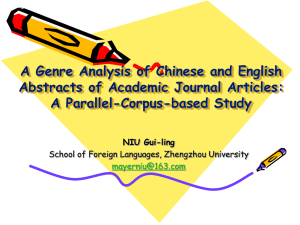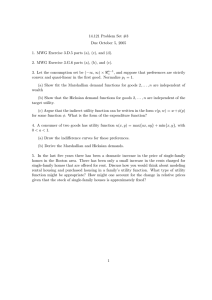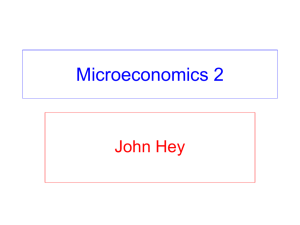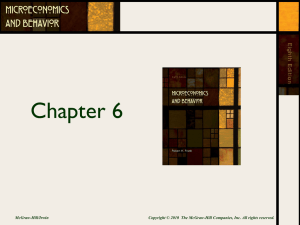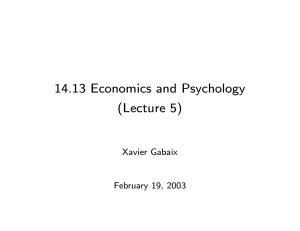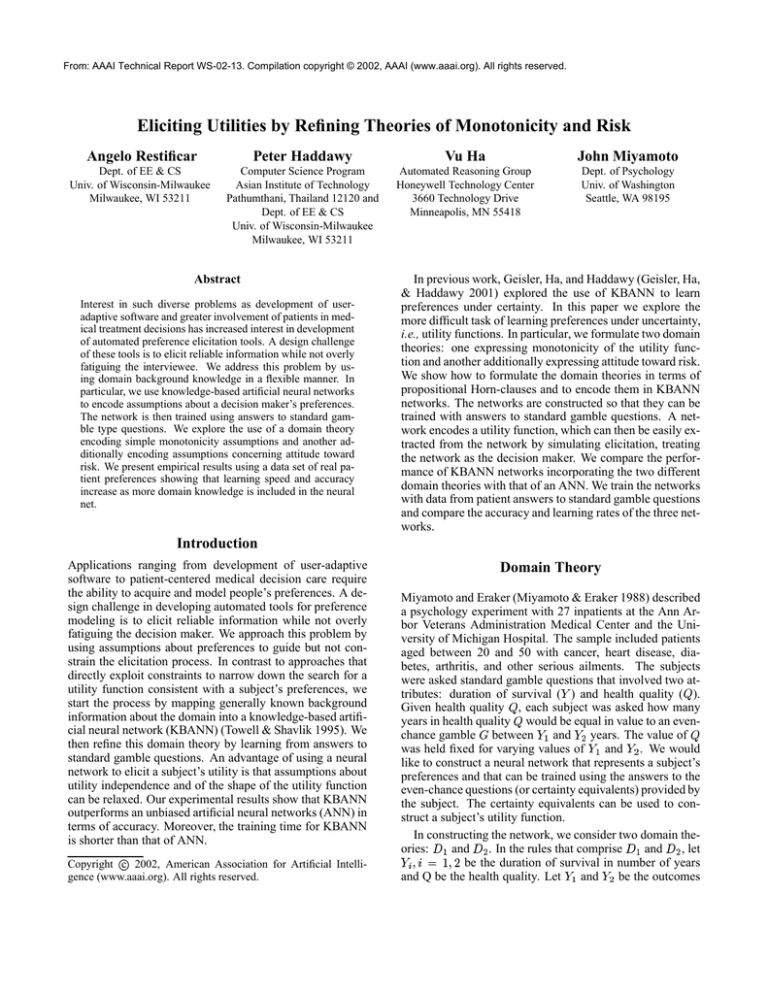
From: AAAI Technical Report WS-02-13. Compilation copyright © 2002, AAAI (www.aaai.org). All rights reserved.
Eliciting Utilities by Refining Theories of Monotonicity and Risk
Angelo Restificar
Peter Haddawy
Vu Ha
John Miyamoto
Dept. of EE & CS
Univ. of Wisconsin-Milwaukee
Milwaukee, WI 53211
Computer Science Program
Asian Institute of Technology
Pathumthani, Thailand 12120 and
Dept. of EE & CS
Univ. of Wisconsin-Milwaukee
Milwaukee, WI 53211
Automated Reasoning Group
Honeywell Technology Center
3660 Technology Drive
Minneapolis, MN 55418
Dept. of Psychology
Univ. of Washington
Seattle, WA 98195
Abstract
Interest in such diverse problems as development of useradaptive software and greater involvement of patients in medical treatment decisions has increased interest in development
of automated preference elicitation tools. A design challenge
of these tools is to elicit reliable information while not overly
fatiguing the interviewee. We address this problem by using domain background knowledge in a flexible manner. In
particular, we use knowledge-based artificial neural networks
to encode assumptions about a decision maker’s preferences.
The network is then trained using answers to standard gamble type questions. We explore the use of a domain theory
encoding simple monotonicity assumptions and another additionally encoding assumptions concerning attitude toward
risk. We present empirical results using a data set of real patient preferences showing that learning speed and accuracy
increase as more domain knowledge is included in the neural
net.
In previous work, Geisler, Ha, and Haddawy (Geisler, Ha,
& Haddawy 2001) explored the use of KBANN to learn
preferences under certainty. In this paper we explore the
more difficult task of learning preferences under uncertainty,
i.e., utility functions. In particular, we formulate two domain
theories: one expressing monotonicity of the utility function and another additionally expressing attitude toward risk.
We show how to formulate the domain theories in terms of
propositional Horn-clauses and to encode them in KBANN
networks. The networks are constructed so that they can be
trained with answers to standard gamble questions. A network encodes a utility function, which can then be easily extracted from the network by simulating elicitation, treating
the network as the decision maker. We compare the performance of KBANN networks incorporating the two different
domain theories with that of an ANN. We train the networks
with data from patient answers to standard gamble questions
and compare the accuracy and learning rates of the three networks.
Introduction
Applications ranging from development of user-adaptive
software to patient-centered medical decision care require
the ability to acquire and model people’s preferences. A design challenge in developing automated tools for preference
modeling is to elicit reliable information while not overly
fatiguing the decision maker. We approach this problem by
using assumptions about preferences to guide but not constrain the elicitation process. In contrast to approaches that
directly exploit constraints to narrow down the search for a
utility function consistent with a subject’s preferences, we
start the process by mapping generally known background
information about the domain into a knowledge-based artificial neural network (KBANN) (Towell & Shavlik 1995). We
then refine this domain theory by learning from answers to
standard gamble questions. An advantage of using a neural
network to elicit a subject’s utility is that assumptions about
utility independence and of the shape of the utility function
can be relaxed. Our experimental results show that KBANN
outperforms an unbiased artificial neural networks (ANN) in
terms of accuracy. Moreover, the training time for KBANN
is shorter than that of ANN.
Copyright c 2002, American Association for Artificial Intelligence (www.aaai.org). All rights reserved.
Domain Theory
Miyamoto and Eraker (Miyamoto & Eraker 1988) described
a psychology experiment with 27 inpatients at the Ann Arbor Veterans Administration Medical Center and the University of Michigan Hospital. The sample included patients
aged between 20 and 50 with cancer, heart disease, diabetes, arthritis, and other serious ailments. The subjects
were asked standard gamble questions that involved two attributes: duration of survival ( ) and health quality ( ).
Given health quality , each subject was asked how many
years in health quality would be equal in value to an evenchance gamble between and years. The value of was held fixed for varying values of and . We would
like to construct a neural network that represents a subject’s
preferences and that can be trained using the answers to the
even-chance questions (or certainty equivalents) provided by
the subject. The certainty equivalents can be used to construct a subject’s utility function.
In constructing the network, we consider two domain theories: and . In the rules that comprise and , let
be the duration of survival in number of years
and Q be the health quality. Let and be the outcomes
G > YCE
Y1 > Yce & Y2 ≥ Yce
Y1 ≥ Yce & Y2 > Yce
Y2 ≥ Yce
Y1 > Yce
Y2 > Yce
YCE > G
Y2 = Yce
Y1 ≥ Yce
Y1 > Yce
Y1
Y1 < Yce & Y2 ≤ Yce
Y2 > Yce
Y1 < Yce
Y1 = Yce
Y2 < Yce
Y2
!
!
" $#&% (' )#+*,
!
!
' #&% (/ #+*,
!
!
0 #&% ' #+*,
!
!
0' 2#&% " 3#+*,
!
.-/ )#
.-/ #
!
1- #
!
- #
!
(1)
(2)
(3)
(4)
Rules 1 and 2 say that whenever the outcomes of the evenchance gamble dominate , the decision-maker prefers the
gamble. Rules 3 and 4 say that in cases where dominates
the outcomes of the gamble, the decision maker prefers .
Before we present the rules that comprise the second domain theory, we must first define proportional match. The
concept of proportional match allows us to compare certainty equivalents for different pairs of values of and in an even-chance gamble.
Definition 1 Let be the certainty equivalent of an evenchance gamble . Let and , where 4 , be the
outcomes of , each of which has a 50% chance of occurring. A proportional match 56 corresponding to is
defined as follows:
56
+* * The motivation behind the use of the proportional match is
to allow us to encode information about a decision-maker’s
1
An even-chance gamble means that both 78 and 7:9 each has a
50% chance of occurring.
Y2 = Yce
Yce
Q
Figure 1: KBANN with in an even-chance gamble 1 , , be the certainty
equivalent of the gamble, and be any arbitrary outcome
for certain. The first domain theory, , consists of rules
that implicitly specify the independence of and , as well
as the fact that the utility is monotonically increasing in .
Since is held fixed in each question, it need not appear in
the rules. consists of the following rules:
Y2 ≤ Yce
Y1 ≤ Yce & Y2 < Yce
Y1 ≤ Yce
Y1 < Yce
Y2 < Yce
Y1 = Yce
and
or
comparison
risk attitude into the domain theory. The rules that comprise
are as follows:
!
!
;/ #&% ' #<*,
!
!
;' )#&% $#<*,
!!
= +* ># 56@?BADCE 3#<*,
!!
<* 3# 56EF>CE 3#<*,
!
.- #
(5)
(6)
.- $#
!
(7)
.- $#
!
-" #
(8)
In , Rules 5 and 6 are the same as in!H! . Rules 7 and 8
encode
!H! attitude toward risk. Note that G 0* ># 56@?IAJC
# * # 56 F> CK #ML is another way of writing
in interval form. This representation allows flexibility
when approximating . Rule 7 say that a decision-maker
prefers to gamble if = . On the other hand, Rule 8
say that is preferred whenever 0 .
!
Using KBANN to Model Utilities
KBANN (Towell & Shavlik 1995) is a hybrid learning system that allows rules in propositional logic to be mapped into
neural networks. The mapping of rules into the network correspond to modelling preferences without an extensive set
of examples. The preference information is then refined by
learning from answers to standard gamble questions. Unlike an Artificial Neural Network (ANN), in KBANN the
weights of the links that correspond to the domain theory
are given higher values, in effect creating biased links. In
our experiments, the weight, N , is set to 4. All other links
are randomly initialized to a value near 0.
The network has three hidden layers, an input layer, and
an output layer . This is true for both domain theories, and . For domain theory (see Fig. 1), the input layer
consists of 4 nodes: , , , and . The health state
is held at throughout for both and . For O (see
Fig.
!! 2), the input layer consists
!H! of 6 nodes: , , , ,
* 3# 56@?IA0CP ># and ;* 3# 56EF>QCR 3# . The
and
or
comparison
G > YCE
Y1 > Yce & Y2 ≥ Yce
Y1 > Yce
Y1 ≥ Yce & Y2 > Yce
Y2 ≥ Yce
Y2 > Yce
YCE > G
Y2 = Yce
Y1 ≥ Yce
Yce ≤ (Y1 -Y2)PMlo+ Y2
Y2 > Yce
Y1 > Yce
Y1
Yce < (Y1 -Y2) PMlo + Y2
Y2
output layers for both and consist of 2 nodes: The
left output node is for S-RTVU . This node gives an output
near 1 if either Rule 1 or Rule 2 for domain theory is true
or if either Rule 5, Rule 6, or Rule 7 for domain theory is true. Otherwise it gives an output near 0. The right output
node is for TVU-W . It outputs a value near 1 if either
Rule 3 or Rule 4 for domain theory is true, or if Rule 8
for domain theory O is true. Otherwise, an output near 0 is
produced.
In both networks, the hidden layer contains a mixture of
, ' , X , and = comparison nodes. The ' nodes are implemented as OR nodes, which output a value near 1 if either
Y [Z or Y \Z is true. The weights of the incoming links
for an Y Z node are N for Y and * N for Z . The activation
function used to implement the node is:
(9)
The activation function in Equation (9) gives an output close
to 1 if Y RZ , an output close to 0.5 if Y mZ , and an output
close to 0 if Y XnZ . op^>q rsut:vq is the usual sum of the
product: weight of the link w activation output. Like the
operator, the weights of the incoming links for an Y \Z
node are also * N for Y and N for Z . The activation function
for this operator is:
j
b
y
]C_^`Qag`x c<Megfdh>i2k>e y z&{Hl
Yce = (Y1 -Y2)PMhi+ Y2
Yce = (Y1 -Y2)PMlo+ Y2
Y1 = Yce
Yce
Figure 2: KBANN with ]C_^`Qa bdcJegfhji)k>egl
Yce > (Y1 -Y2)PMhi+ Y2
(10)
Equation (10) gives an output near 1 if Y and Z have values that are close to each other. However, as their difference widens the activation function produces values toward
0. The AND and OR nodes are implemented as:
(11)
<
c
M
g
e
d
f
]C_^`Qa !M h>i2k>eg| `} ~) |l
*# N for AND node and u
1 : N
where Mu
;
Q
(Y1 -Y2)PMhi+ Y2
(Y1 -Y2)PMlo+ Y2
for an OR node.
is the number of positive antecedents
on a rule, e.g., Rule (5) has a value of 5 . The initial
weights of unbiased links, i.e., weights that are not initialized to either N or * N , are randomly set to a value in the
interval G *0 L .
Empirical Analysis
We evaluated our approach using the KBANN representations of domain theories and , and an artificial neural
network (ANN) with 4 input nodes, 3 nodes in the hidden
layer, and two nodes in the output layer. We used the set
of data from (Miyamoto & Eraker 1988) which contains the
answers of 27 subjects who were asked even-chance gamble questions concerning years of survival and the quality of
life. Given health quality , each subject was asked how
many years in health quality would be equal in value to
an even-chance gamble between and years. In this
data set, was held fixed for varying values of and .
There are 24 such questions with varying values in years
of survival and health quality for each of the subjects. The
answers to the even-chance gamble questions are values of
. Since we know what the gamble is worth to the subject, answers for values that are greater than and values
that are less than are implicit: the subject prefers the
gamble to values below and prefers values above to the gamble. Thus to provide the networks with data to
specify preferences for values above and below we can
simply supplement the answers to the standard gamble questions by including answers that are implicit. We do this by
including in the training set for both KBANN and ANN randomly generated data points that are above and below the
subject’s . We have generated 50 such points for each
of above and below regions. The networks include an
input node for a value of for certain labeled . We di-
network performance
accuracy
0.9
0.8
KBANN with
D2
0.7
KBANN with
D1
0.6
ANN
22
19
16
13
10
7
4
1
0.5
leave-x
Figure 3: Accuracy comparison between networks
vided the data set into a training set, a tuning set, and a test
set. For each 223) of the 24 answers, we leave out
answers for testing purposes and train the network with the
remaining O_ answers. We used early stopping with a
look-ahead of 100 epochs to avoid overfitting and used 10%
of the training examples as the tuning set. To obtain the accuracy we simply took the percentage of the test points that
are correctly classified. There are 24 experiment runs for
each leave-x for a particular subject. The values obtained are
averaged to get the prediction accuracy for each leave-x for a
particular subject. The results of the experiment for each of
the 27 subjects are averaged over all leave-x, ]23 .
Figure 3 shows the accuracy of KBANN evaluated for
risk prone subjects using domain theory O (top curve),
KBANN for all subjects using domain theory (middle
curve), and that of ANN for all subjects (bottom curve).
For
¡¢ the risk-prone experiment, only subjects whose average
of the corresponding £¤¥ ¦ greater than §: ¨¨ and with
a standard deviation © ªQ«­¬®§B were evaluated. The performance of KBANN using domain theory is better than
the performance of KBANN using domain theory . Also
KBANN with
performs better than ANN. A right-tailed
¯ test on the difference between the accuracy of KBANN
with and ANN shows significance in 22 out of 23 tests
at 90% confidence level. As the size of the training set
decreases, the dominance of KBANN over ANN becomes
more pronounced. This difference from leave-17 to leave23 is statistically significant at 95% confidence level. Moreover, KBANN with requires less training time compared
to KBANN with
and ANN. Figure 4 shows the average
number of epochs required to train the networks as the number of training examples decreases, i.e., leave-x increases.
Related Work and Summary
Preference elicitation has become an important tool in
medical-decision making. For example, to assess the costeffectiveness of a treatment under study against other commonly accepted treatments, it is often necessary to measure the patients’ preferences. Unlike human assessors who
may potentially influence the results of the utility elicitation,
automated methods of elicitation allow for a uniform process of obtaining patients’ preferences. More importantly,
responses maybe more frank in computer interviews than
when responding on paper or to a human being(Locke et
al. 1992). In a separate study reported in (Sanders et al.
1994), majority of the patients preferred to use the computer
to disclose sensitive information regarding risk behaviors.
U-titer (Sumner, Nease, & Littenberg 1992) is an automated,
modular, utility assessment tool that allows the following
methods of assessments: rating scale, category scaling, standard gamble, and time trade-off. The development of U-titer
grew out of the need to find an assessment tool that minimizes systematic biases that may be present in interviews
conducted by human assessors. Until the development of Utiter, computer-based assessment tools were considered to
be too expensive.
IMPACT (Lenert et al. 1995) or Interactive Multimedia
Preference Assessment Construction Tool is designed to
measure health preferences and provide support for the rapid
construction of multimedia computer interviews. IMPACT
has two parts: an editor and a player. The editor part is a
multimedia shell program that allows researchers to interactively construct patient interviewing instruments without
the need for programming. It supports text, graphics, synthesized speech, digital sound and Quicktime movies. Validation studies show that preference assessments using IM-
1000
800
ANN
KBANN with D1
KBANN with D2
600
400
200
22
19
16
13
10
7
4
0
1
number of epochs
training times
leave-x
Figure 4: Comparison of training times between networks
PACT have high test-retest reliability and that most subjects
understand the elicitation methods and believe that explanations were provided clearly. Recently, IMPACT was developed further into iMPACT3 to support the construction
of instruments via the internet (Lenert 2000). Our work
complements tools like U-titer and IMPACT. The number
of questions the interviewee has to answer using U-titer and
IMPACT may be reduced by exploiting information that has
already been learned via the networks. If during the first few
questions the network predicts the interviewee’s answers
with good accuracy then the network represents a good approximation of the interviewee’s utility function. We need
ask only additional number of questions to retrain the network if its predictive accuracy falls below a certain threshold.
Theory refinement via KBANN has been shown to effectively elicit and model user preferences in the certainty
case(Geisler, Ha, & Haddawy 2001). This also provides a
robust method of representing preferences in the case where
independence assumptions have been violated to some degree. Empirical evaluation in a flight domain shows that the
approach can significantly reduce the amount of information
to be asked from the user. User preferences in the form of
instructions are used to construct intelligent agents with the
KBANN network as the core machine learning component
in the Wisconsin Adaptive Web Assistant (WAWA) (EliassiRad & Shavlik 2001). The networks are initially constructed
from users’ advices and refined via system-generated and
user-supplied examples. Empirical results show that the theory refinement approach is highly effective in the task of
retrieving and extracting information from the web.
In more recent work, (Chajewska, Koller, & Ormoneit
2001) propose an approach that estimates a probability distribution over possible courses of action of a user by observing the user’s past decisions. The idea is to view the past
decisions as constraints to be used to condition a prior probability distribution in order to obtain an estimate of the posterior probability distribution. Since this proposed method
refine prior knowledge of utility functions, they can also be
viewed as a form of theory refinement. We see the method
as complementary to ours. However, our approach allows us
to capture and represent utilities without the need to know
the explicit utility equation.
In this paper, we have outlined an approach to utility elicitation by refining a domain theory. Our experiments show
that encoding domain rules into a KBANN and refining it
results in a reduction in training time and a significant improvement in accuracy over ANN. Moreover, our empirical
results suggest that the inclusion of additional relevant information into the domain theory also improves prediction
accuracy. Software tools like IMPACT or U-titer may be
able to reduce the number of questions that will be asked
from the interviewee by exploiting the information already
represented in the network.
References
Chajewska, U.; Koller, D.; and Ormoneit, D. 2001. Learning an agent’s utility function by observing behavior. In
Proceedings of the International Conference on Machine
Learning.
Eliassi-Rad, T., and Shavlik, J. 2001. A system for building intelligent agents that learn to retrieve and extract information. International Journal on User Modeling and
User-Adapted Interaction, Special Issue on User Modeling
and
° Intelligent Agents.
Geisler, B.; Ha, V.; and Haddawy, P. 2001. Modeling user
preferences via theory refinement. In Proceedings of the
Conference on Intelligent User Interfaces (IUI).
Lenert, L. A.; Michelson, D.; Flowers, C.; and Bergen,
M. R. 1995. IMPACT: An object-oriented graphical environment for construction of multimedia patient interviewing software. In Proceedings of the Annual Symposium on
Comp Application to Medical Care, 319–323.
Lenert, L. A. 2000. iMPACT3: Online tools for development of web sites for the study of patients’ preferences and
utilities. In Proceedings of the AMIA Annual Fall Symposium, 1172.
Locke, S. E.; Kowaloff, H. B.; Hoff, R. G.; Safran, C.;
Popovsky, M. A.; Cotton, D. J.; Finkelstein, D. M.; Page,
P. L.; and Slack, W. V. 1992. Computer-based interview
for screening blood donors for risk of HIV transmission.
JAMA 268(10):1301–1305.
Miyamoto, J. M., and Eraker, S. A. 1988. A multiplicative
model of the utility of survival duration and health quality.
Journal of Experimental Psychology: General 117(1):3–
20.
Sanders, G. D.; Owens, D. K.; Padian, N.; Cardinalli,
A. B.; Sullivan, A. N.; and Nease, R. F. 1994. A computerbased interview to identify HIV risk behaviors and to assess patient preferences for HIV-related health states. In
Proceedings of the Annual Symposium on Comp Application to Medical Care, 20–24.
Sumner, W.; Nease, R.; and Littenberg, B. 1992. U-titer:
A utility assessment tool. In Proceedings of the Annual
Symposium on Comp Application to Medical Care, 701–
705.
Towell, G. G., and Shavlik, J. W. 1995. Knowledge-based
artificial neural networks. Artificial Intelligence 70.

